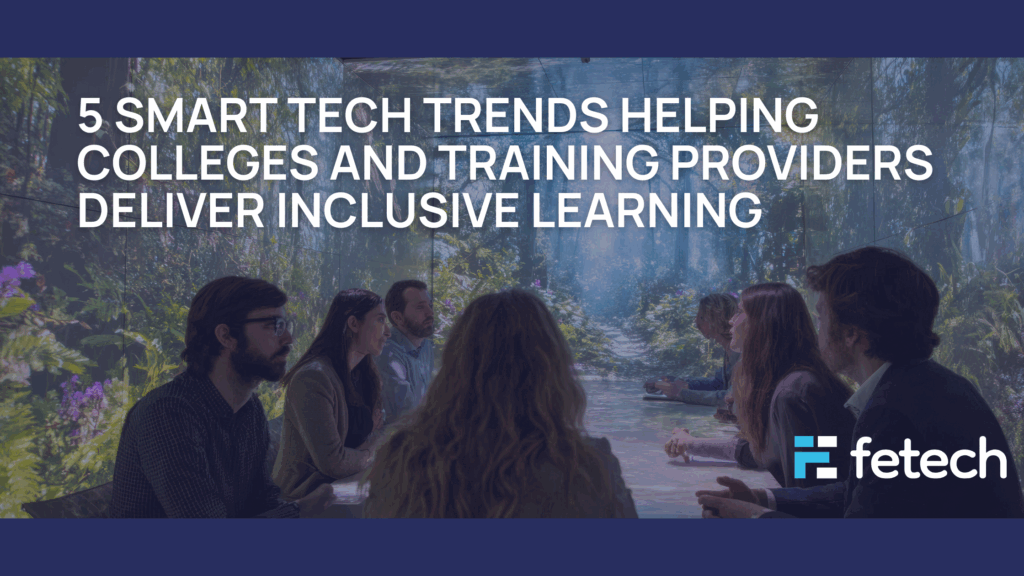5 smart tech trends helping colleges and training providers deliver inclusive learning

Inclusion is no longer optional. It’s a core priority for colleges and training providers in 2025/26.
According to the UK Department for Education, almost 20% of learners in England have been identified as having special educational needs. But leading edtech screening tools show the figure is closer to 35% once learners are assessed for additional learning support (ALS).
That is a big jump – from 1 in 5 to 1 in 3 – and it means that thousands could be missing out on the help they need. At the same time, colleges and ITPs are under pressure to identify needs early, show what’s working, and prove impact – all while balancing tight budgets and stretched teams.
As a marketplace, we’re seeing colleges and ITPs use smart technology effectively to create more inclusive learning environments and meet rising expectations with clear, measurable results.
Here are 5 smart tech trends that are already making a difference:
1. Early identification through screening assessments
The earlier you know what a learner needs, the faster you can make a difference.
That’s why more providers are investing in robust, digital screeners that can flag issues like memory, attention, or processing difficulties, often before a formal diagnosis is even on the radar.
These tools typically:
◉ Take around 30 minutes
◉ Give staff actionable insights
◉ Enable support to be put in place straight away
We’ve seen time and again that early intervention changes outcomes. Schools proved it with Sure Start – and FE is no different. The sooner learners get the right support, the more confident, motivated, and ready to succeed they become.
2. Support apps that build independence
For learners with ADHD, autism, or anxiety, staying organised can be a real challenge. So more providers are turning to simple, accessible apps that support executive functioning. These tools help with planning, time management, and task completion.
They’re intuitive, low-cost, and easy to roll out across different courses. More importantly, they help learners manage workload more independently, reducing the pressure on support teams and helping learners build confidence and self-reliance, both at college and beyond.
3. Accessible, interactive digital content
As more learning happens online or in hybrid formats, there’s a real opportunity to design content that works for everyone. The best digital courses are built with accessibility in mind from the start.
This includes:
◉ Screen reader compatibility
◉ Captioned videos
◉ Flexible pacing
◉ Interactive elements that help learners engage at their own speed
When content is designed this way, it naturally supports different learning styles, and it creates a clear trail of evidence around engagement and progress. In fact, a recent Jisc survey found that 85% of students rated their college’s digital learning environment as good or better. That’s a strong signal that inclusive, interactive content really does make a difference.
4. Immersive virtual work experience
Real-world placements are invaluable – but they’re not always easy to arrange. Logistics, transport, supervision, and limited opportunities can all get in the way. That’s where virtual reality is starting to play a bigger role.
Colleges and training providers are using VR to simulate real workplaces, providing learners with hands-on experience in a safe and controlled environment. This scalable solution not only reduces placement costs but also offers practical insight into various industries. It’s especially beneficial for students who feel anxious in new settings, face mobility challenges, or live in rural areas with limited local opportunities.
5. Practical teaching strategies that support every learner
Teachers want to support every student, but they also need tools that fit into busy schedules. That’s why online platforms offering quick, evidence-based strategies for inclusive teaching are becoming increasingly popular.
They’re easy to apply, work across different subjects, and help staff feel more confident in meeting a wide range of learner needs. Best of all, they make inclusive teaching part of the everyday classroom experience, not an extra job on top.
Inclusion that works for everyone
Every college is different – and so is every learner. But with the right tools in place, it’s possible to build inclusive environments that support both students and staff.
These five tech trends are already helping colleges and ITPs take practical steps towards inclusion, while also freeing up time and resources.
👉 Want to explore how these approaches could work in your setting? We’d love to chat.
👉 Or, become a member and unlock more insights, ideas, and resources here.